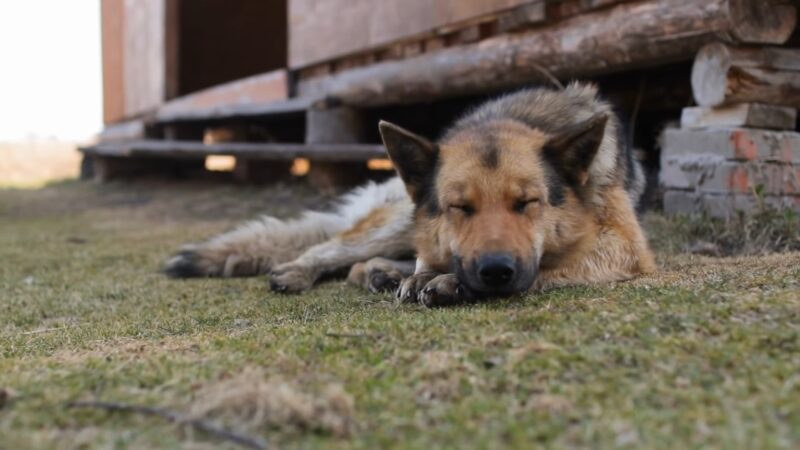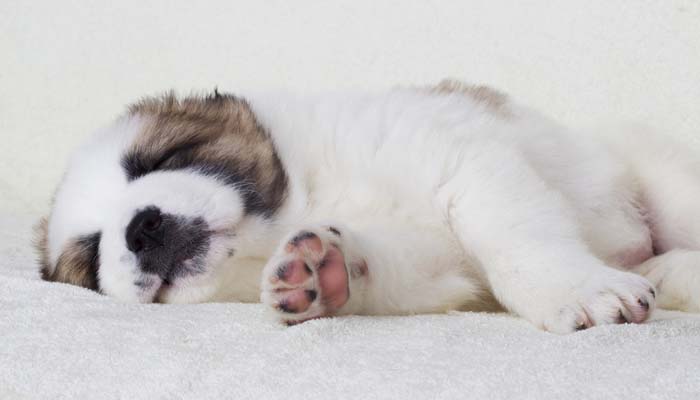Our furry friends, our beloved pets, absolutely adore their slumber time. It’s fascinating to observe their sleeping habits, but we need to remember that dogs have a sleep pattern that’s quite different from ours, humans.
Now, just like how every dog has its own personality, their snoozing patterns also vary depending on their breed and size. For instance, smaller breeds tend to sleep less compared to their larger counterparts.
In this little article, we’re going to delve into the intriguing world of our canine companions’ sleep. We’ll explore how much dogs actually sleep, decode the meanings behind their sleeping positions, and shed some light on common sleep problems that can affect our precious pooches. So, let’s cozy up and embark on this delightful journey to understand our dogs’ dreams and their slumber-filled world.
So, how much do dogs sleep anyway?
The average amount of time to sleep in a 24 hour period is between 12 and 18 hours.
However, there are some different factors listed below that could affect your dog’s sleeping patterns, making them sleep slightly more or less than the average.
Even though every breed and even every dog is different, the following is very common among many of our loyal friends.
Have you ever noticed that when you are home, your dog may only be awake a few hours a day, but then when you bring them on a hike or to the lake, they can run and play all day without stopping?
The reason for such an unusual behavior is because, unlike humans, puppies don’t have a regular sleeping pattern.
There are two stages of sleep:
- Slow-wave sleep (SWS), which is a lighter type of sleep with less brain activity
- Rapid eye movement (REM), which is a deeper type of sleep with higher brain activity
They spend between 8 and 12 percent of their sleep time in the so called REM “mode”.
While comparably, humans spend between 20 and 25 percent of their sleep time in REM.
Now the difference between humans’ and canines’ sleep is that our pets’ sleep journeys are in much shorter bursts than humans, so they are less likely to get into the REM sleep stage.
Since they don’t get as much deep sleep, they end up needing more rest in general, thus they are napping whenever there’s an opportunity.
There are many factors that can help you determine the average time that your dog should spend sleeping every day. Those include:
- Age: puppies and senior typically need more sleep than middle-aged dogs.
- Activity level: generally, that are less active are more likely to nap out of boredom than active dogs or working.
- Diet: poor quality dog foods have added fillers and lack of necessary vitamins, and they don’t give the nutrition and energy it needs to keep up an active lifestyle. The fillers in poor quality food are harder for body to digest which can make them feel sluggish and affect their sleeping patterns.
- Breed and size: larger ones need more sleep than smaller.
Remember to check with our page on what proper canine nutrition looks like.
If you’re trying to optimize diet, see food ratings for a more accurate, objective assessment on what’s best for your canine.
Different sleeping positions of your dog

Like people, most dogs have a favorite sleeping position that they are most comfortable in.
There are four typical sleeping positions for most, and each position can demonstrate different characteristics of your pet.
The four sleeping positions include:
- Side sleeping
- Back sleeping
- Curled in a ball
- Back to back
Let’s start with the most popular one.
Side sleeping. When a dog is sleeping on his/her side or belly with all four paws stuck out.
Usually, this position is only for napping, but occasionally they will sleep like this for longer periods of time. This is the most common and comfortable position for when they are very relaxed.
Back sleeping. Possibly one of the funniest and cutest positions to see your dog sleeping in.
This is when they are stretched out on their back with all four paws in the air. There could be two reasons for back sleeping.
The first possible reason dogs do this is to expose their belly. The belly is one of the few places with little to no hair, and exposing it is one of the fastest ways to cool off. The second reason is because in back sleeping position all of the dog’s muscles are able to relax completely, and it’s a sure sign of comfort and submission.
Curled in a ball. Another very common napping position in canines.
In order to hold this position, your puppy must use multiple of his/her muscles. This is not a relaxed position by any means.
They can get up and begin move very quickly when sleeping in this position, and you will see a lot of abused sleep like this. They will also sleep curled in a ball when in a new environment or surrounded by new people as they are always trying to stay alert.
Back to back (or touching). Either their owner or another – while sleeping shows attachment and affection.
Wild dogs tend to sleep next to each other in their packs, and this is your dog’s instinctual way of showing you, or another dog, that you are part of their pack.
Sleeping disorders

Sleep disorders are very uncommon, but they do exist.
Remember that while it’s okay for people to have problems with sleep, in canines this can possibly be a red flag for another, more or less serious, condition.
The five main causes for sleeplessness are:
- Physical discomfort, including but not limited to, arthritis in dogs, hip dysplasia or other hip injury, parasite or flea infestation, allergies, or urinary incontinence.
- Emotional disorders including stress, anxiety and depression.
- Side effects of medication.
- Old age, which is also associated with many different painful conditions.
- Lack of activity during the day, making them still feel energetic when they should be resting.
Consulting with your vet is the best method for diagnosing and treating if you believe they have a sleep disorder.
One last thing to mention is the environment where your puppy sleeps in.
You may think that dogs are fine sleeping anywhere – and they usually will without complaining – but just like us, they want a comfortable place to sleep, which they normally start considering their own.
Some like to sleep in a more sheltered place like under a table, under your bed or various corners. Other dogs like to nest in blankets or other soft material before lying down.
Giving your puppy a place to sleep where they feel most comfortable and at home is the best way to ensure a good night’s rest for your pooch.
Whether is large or small, it likely that they will spend a significant amount of time sleeping.
You should find the sleeping arrangement that works best for both you and your pet. Thinking about such an arrangement before getting a pet is never a bad idea.
Also, try not to wake your dog unless absolutely necessary because you never know how they could react if you disturb and/or scare them.
They deserve to have their rest. Making sure that your pet has the right balance of activity and sleep is one of the keys to a healthy and happy doggy life.
Bottom Line
Understanding our puppies sleep patterns is crucial to ensuring their well-being and happiness. Dogs sleep between 12 to 18 hours a day, but individual factors like breed, size, age, and activity level can influence their snoozing habits. Knowing the meaning behind their favorite sleeping positions, such as side sleeping, back sleeping, curled in a ball, and back to back, helps us better connect with our furry companions.
While sleep disorders are rare, it’s essential to watch for signs of discomfort or emotional distress. Providing a cozy and comfortable sleeping environment for our canine pals contributes to their overall health and contentment. Remember, a well-rested is a happy dog!







